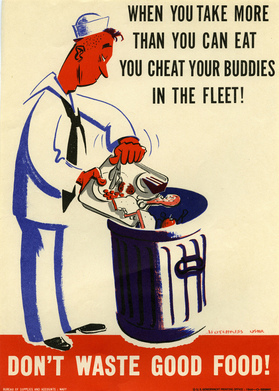 This past January, the European Parliament adopted a resolution to reduce food waste by 50 percent by 2020 and designated 2014 as the “European year against food waste.” Members of the European Parliament have called improving the efficiency of our food system and reducing food wastage “a matter of urgency,” stating that:
This past January, the European Parliament adopted a resolution to reduce food waste by 50 percent by 2020 and designated 2014 as the “European year against food waste.” Members of the European Parliament have called improving the efficiency of our food system and reducing food wastage “a matter of urgency,” stating that:
The most important problem in the future will be to tackle increased demand for food, as it will outstrip supply. We can no longer afford to stand idly by while perfectly edible food is being wasted. This is an ethical but also an economic and social problem, with huge implications for the environment.
Additionally, the United Kingdom government has helped conduct a public awareness campaign called Love Food Hate Waste that plastered London with fancy billboards encouraging people to waste less food.
And what has the U.S. government done to tackle food waste? Close to nothing.
 OK, that’s not entirely true. During World War II, the U.S. government had a massive campaign, with posters that still make for good kitchen decorations, to discourage wasted food in order to save food for the army. One of my favorites is “When you take more than you can eat, you cheat your buddies in the fleet.”
OK, that’s not entirely true. During World War II, the U.S. government had a massive campaign, with posters that still make for good kitchen decorations, to discourage wasted food in order to save food for the army. One of my favorites is “When you take more than you can eat, you cheat your buddies in the fleet.”
But since then, there hasn’t been a whole lot of action. The EPA runs a laudable-for-its-meager-budget Food Recovery Challenge that provides recognition and shares best practices for businesses preventing and recovering food waste. There’s also one team at USDA which, as only part of its responsibilities, collects some information about food losses at the retail and consumer levels of the supply chain. Other than that, the government’s involvement is pretty barren.
Our neighbors across the pond show us we’ve got a lot of catching up to do in terms of prioritizing food waste reduction at a national level. It is due time for the U.S. government to act on the food waste crisis with real urgency and leadership as well.
As discussed in NRDC’s recent report about improving the efficiency of the U.S. food system, about 40 percent of food in this country goes uneaten — a situation that is imposing staggering social, financial, and environmental costs. Government, businesses, and individuals all have a key role to play in bringing that number down. Next week, we’ll look at how businesses can turn this into opportunity. For the government’s part, here are a few recommendations on what could be more of a priority at the federal level.
Conduct a comprehensive study of food losses throughout the U.S. food system
The adage “you manage what you measure” applies. Food loss isn’t being measured or studied, so it’s difficult to understand or evaluate our progress. That’s why we need a comprehensive report on food loss throughout the U.S., so we can identify hot spots and opportunity areas, set baselines against which improvement can be measured, and provide more detailed and accurate data. A similar study, completed by the European Commission in 2010, was an important first step in establishing reduction goals.
Establish national goals
Reducing food loss in the United States should be a national priority, starting with the establishment of clear and specific efficiency improvement targets as was done in Europe.
Address date labeling confusion
As I’ve written about before, “use-by” dates do not necessarily indicate food safety. Sadly, most consumers toss food after it has “expired” nonetheless. The U.K. recently set guidelines to standardize date labeling on foods, after research there suggested clarifying its meaning to the public could reduce household food losses by as much as 20 percent. And the European Commission concluded that “date labeling coherence” is one of the top three policy priorities for the European Union when it comes to reducing food waste.
Incentivize food recovery
Only about 10 percent of surplus edible food is currently recovered in the United States. Clearly, we can do much better. Two tax programs that could help with this are:
- Small business enhanced tax deduction: An enhanced tax deduction for smaller businesses that donate food expired in December 2011. Unless Congress votes to extend this provision, only large businesses (known as C corporations) will be eligible for the deduction. Proposed bill H.R. 3729 would go even further by making the deduction for food donation permanent for smaller businesses, raising the cap for total deductions for food donations, and codifying other related aspects of the tax code.
- Farm-level tax credits: In January of 2012, the state of California joined Arizona, Oregon, and Colorado in offering a tax credit for donations of excess farm produce to state food banks. A national version of the policy, which offered farms across the country money back for their donations of fresh produce, could make a huge impact.
Improve public awareness
Love Food Hate Waste, the U.K.’s major public-awareness campaign (complete with meal portion and planning guides), has been extremely successful. Avoidable household food waste has dropped 18 percent in the five years since the campaign was launched, though increased food prices likely played a part in that as well. A recent survey by the nation’s Food Standards Agency also found that food waste was one of the top three issues of concern to the public, ranking above food safety. A large similar public campaign featuring widespread communications and celebrity spokespeople could be effective in putting food waste on the radar of American consumers.
There are things we can all do on our own to reduce food waste (see these tips [PDF]), but systemic action needs to come from our nation’s leadership. Let’s raise this issue as a priority at the national level. After all, it’s our resources that are going into growing all that food. And our hungry neighbors who aren’t getting to eat it.



